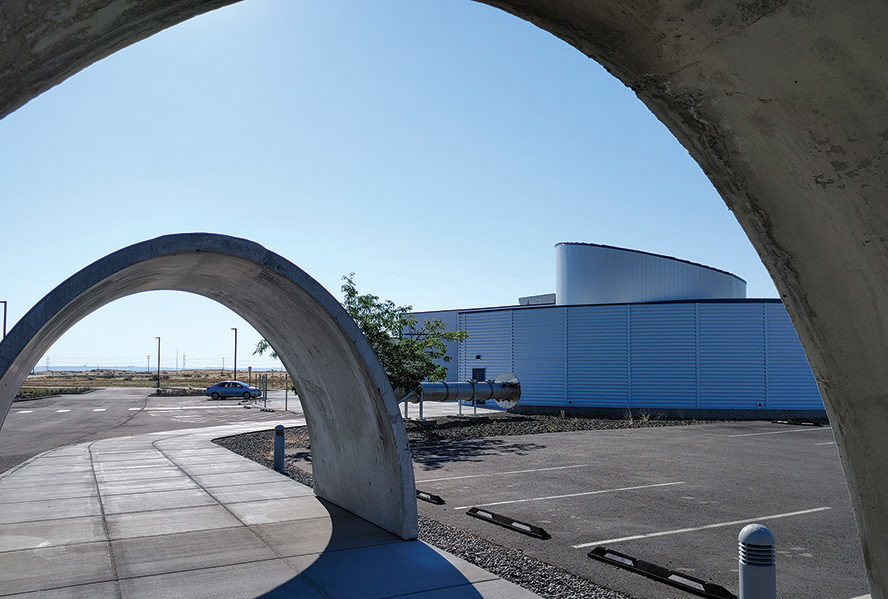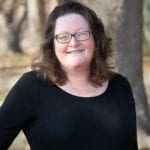
Home » Exploration center caters to science-savvy community
Exploration center caters to science-savvy community

August 11, 2022
The LIGO Hanford Observatory opens its much-anticipated visitor center to school children in September and to the public in October after a delay attributed to the pandemic.
The LIGO Exploration Center, or LExC, is a short walk from the LIGO Hanford Observatory, the gravitational wave observatory whose Nobel Prize-winning work it shares with visitors old and young.
The L-shaped observatory features four-kilometer arms extending from a control center on the Hanford site and along with a twin in Livingston, Louisiana. The pair are part of a larger network that includes Italy’s Virgo observatory and Japan’s KAGRA.
Private tours prove popular
LExC has welcomed private groups, scientists and educators since construction wrapped up in late 2021 but its official January opening was delayed by the Covid-19 pandemic.
Michael Landry, LIGO Hanford’s director, said the popularity of the private tours proves there is interest in the research occurring on a remote patch of the Hanford nuclear reservation. The observatory and LExC are about five miles north of the Benton City junction on the Vantage Highway.
“There is definitely an appetite for it. There is an incredibly science-savvy community here,” he said. Its professional development program for educators draws visitors from across the nation and world.
CalTech and the Massachusetts Institute of Technology, with funding from the National Science Foundation, set up LIGOs in 2015, with Virgo and KAGRA joining the effort in subsequent years.
Virgo teamed with LIGO on the 2017 run and is credited with helping identify the location of a black hole collision. KAGRA joined in 2020 but because that year’s run was cut short by the pandemic it was not an active participant.
All four will participate in the fourth observation run, expected to begin next March following upgrades at the LIGOs. Landry said a fifth observatory is envisioned in India.
The Livingston observatory has long been able to share its work because it has a science education center. LIGO Hanford welcomed visitors at the observatory itself.
Doubling visitor capacity
The state of Washington set aside $7.7 million for a proper STEM education center in 2019.
With the addition, a team of educators and docents led by Amber Strunk can welcome up to 10,000 visitors a year, twice its prior capacity.
“LExC amplifies and focuses everything,” Landry said.
The interferometry network tested Albert Einstein’s century-old prediction that gravitational waves exist. Einstein himself did not think they could be detected. By the mid-1950s, scientists were contemplating how evolving technology might register the miniscule waves that at least theoretically were passing through Earth from distant events.
LExC’s features
LExC features an early piece of equipment that controversially did not detect gravity waves but pioneered the idea that they could be found.
When the first wave was recorded first at Hanford and then Livingston, scientists raced to confirm the results were authentic and not the result of an accident or outside influence.
Landry recalled securing every device that could be tampered with to prevent unplanned tests or “injections,” deliberate or otherwise.
LIGO also records a constant stream of data about conditions on planet Earth, from storms to earthquakes, to avoid false readings. The last thing it wants, Landry said, is to announce a detection that could be attributed to a lightning strike.
They knew they were on solid ground when a second wave rolled through on Christmas Eve, 2015. Subsequent detections were recorded on Jan. 4, 2017, and Aug. 14, 2017.
It took 1.3 billion years for the gravity waves emanating from colliding black stars to travel to Earth and jostle the LIGO lasers. Reaction was swift.
The principals – Rainer Weiss of MIT and Caltech’s Barry Barish and Kip Thorne – shared the 2017 Nobel Prize for Physics.
The Nobel committee allows only three copies of the medal, and mints them itself. One displayed in LExC’s lobby.
Architect Terence “Tere” Thornhill designed it to reflect the black hole collision it celebrates.
DBR Grant Construction constructed the building.
From above, a pair of unevenly sized circles merge, scaled to the size of the actual black holes. White, blue and one amber light twinkle from the lobby ceiling, a nod to the stars.
The roof includes a silo, representing the more typical telescopic observatory, where scientists watch rather than listen for clues about the universe.
A pair of linked classrooms provide space for students and training. Wave-shaped acoustic tiles cover the ceiling. Flooring reflects the sweep of the aurora borealis.
The exhibit hall has space for 50 hands-on and display exhibits. There are 15. Hands-on exhibits let visitors play with the notion of waves and gravity.
Equipment highlights the staggering engineering that drove the three-and-counting observation runs, in 2015-16, 2016-17 and 2019-20.
The observatory has pioneered laser and optical discoveries now being used in industry.
At its simplest, each observatory splits a laser beam along the two arms, bouncing it back and forth. Gravity waves register as slight variations in the time it takes to the main detector. That detector sits on an elaborate “table” suspended on gyroscopes to isolate it from movement.
The ultra-isolated table could have practical applications. Landry noted that Italian authorities intend to place Michaelangelo’s David on a seismically-stable table to reduce the risk his weak ankle might give out, theoretically possible in a seismic event.
Landry’s team is seeking private and government funding to expand its offerings.
Highly sustainable building
LExC has one promise to draw visitors. It is highly sustainable, built with energy and water savings in mind and a pollinator garden informed by local tribes. Some of the more visible features include five charging stations for electric vehicles and concrete pipes that cover walkways. The pipes were left over from construction of the laser tunnels.
LExC was built to sustainability standards of the U.S. Green Building Council’s Leadership in Energy and Environmental Design’s “silver” level, as required for state-funded projects. The LEED plaque will be displayed when the award is confirmed.
Go to: ligo.caltech.edu/WA/page/lexc.
Local News Hospitality & Meetings
KEYWORDS august 2022




